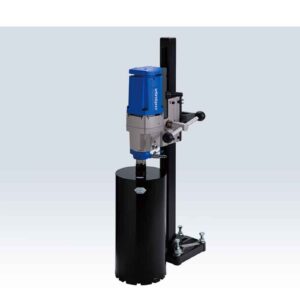Description
Principle
 A steel disc, 25 mm in diameter at a depth of 25 mm, is pulled centrally against a 55 mm diameter counter pressure ring bearing on the surface. The force F required to pullout the insert is measured. The concrete in the strut between the disc and the counter pressure ring is subjected to a compressive load. Therefore the pullout force F is related directly to the compressive strength.
A steel disc, 25 mm in diameter at a depth of 25 mm, is pulled centrally against a 55 mm diameter counter pressure ring bearing on the surface. The force F required to pullout the insert is measured. The concrete in the strut between the disc and the counter pressure ring is subjected to a compressive load. Therefore the pullout force F is related directly to the compressive strength.
Loading is performed either to a required force, in which case the test is nondestructive, or to the peak-load, which results in a slightly raised, 55-mm diameter circular crack on the surface.
The disc is cast into concrete either by attaching it to formwork before placing concrete or by inserting it manually into the fresh concrete. Various LOK-TEST inserts are available.
Correlation and Accuracy of Estimated Strength
LOK-TEST provides an accurate estimate of in-place strength because the peak pullout force has a well-defined correlation to compressive strength measured using standard cylinders or cubes. More than 30 years of correlation experience from all over the world indicates close agreement, suggesting that one general correlation is applicable for all normal density concrete mixtures, as shown below. A different correlation, however, has been found for concrete made with lightweight (low density) aggregate.
 Source: Petersen, C.G., “LOK-Test and CAPO- Test Pullout Testing: Twenty Years Experience,” Conference on Non-Destructive Testing in Civil Engineering, Liverpool, UK, April 1997, British Institute of Non-Destructive Testing
Source: Petersen, C.G., “LOK-Test and CAPO- Test Pullout Testing: Twenty Years Experience,” Conference on Non-Destructive Testing in Civil Engineering, Liverpool, UK, April 1997, British Institute of Non-Destructive Testing
The general correlations shown in the following figure will provide sufficient accuracy for all normal density concrete mixtures. Project specifications, however, may require development of mixture specific correlations. In this case, ACI 228.1R can be used to develop such relationships.
 At the 95 % confidence level and for an average of 4 tests, the estimated compressive strength based on the LOK-TEST and the general correlations indicated above is within ± 6 % of the strength measured from tests of standard specimen (cylinders or cubes) for a maximum aggregate size of 38 mm. The coefficient of variation of individual LOK-TEST results is about 8 % for normal density concrete.
At the 95 % confidence level and for an average of 4 tests, the estimated compressive strength based on the LOK-TEST and the general correlations indicated above is within ± 6 % of the strength measured from tests of standard specimen (cylinders or cubes) for a maximum aggregate size of 38 mm. The coefficient of variation of individual LOK-TEST results is about 8 % for normal density concrete.












Reviews
There are no reviews yet.